The range of AMD hybrid processors designed to work as part of the Socket AM5 desktop platform includes a total of four representatives. We talked in detail about the two older models – the eight-core Ryzen 7 8700G with Radeon 780M graphics and the six-core Ryzen 5 8600G with Radeon 760M graphics. These APUs, based on Zen 4 cores and RDNA 3 graphics architecture, offer unique capabilities – they provide gaming performance no worse than GeForce GTX 1650-level graphics cards with just an integrated graphics core. Thanks to this property, the Ryzen 7 8700G and Ryzen 5 8600G are quite suitable for assembling relatively inexpensive gaming systems, without having to buy a discrete graphics card at all.
However, there is a serious problem with them: for those computers in which it would really make sense to install them, they are still a little expensive. For the amount that you will have to spend on a platform with one of these processors with powerful integrated graphics, you can quite easily purchase a six-core system from the previous generation with a much more powerful video card (like the Radeon RX 6600). This means that there is no obvious economic sense in choosing older APU models for the Socket AM5 platform.
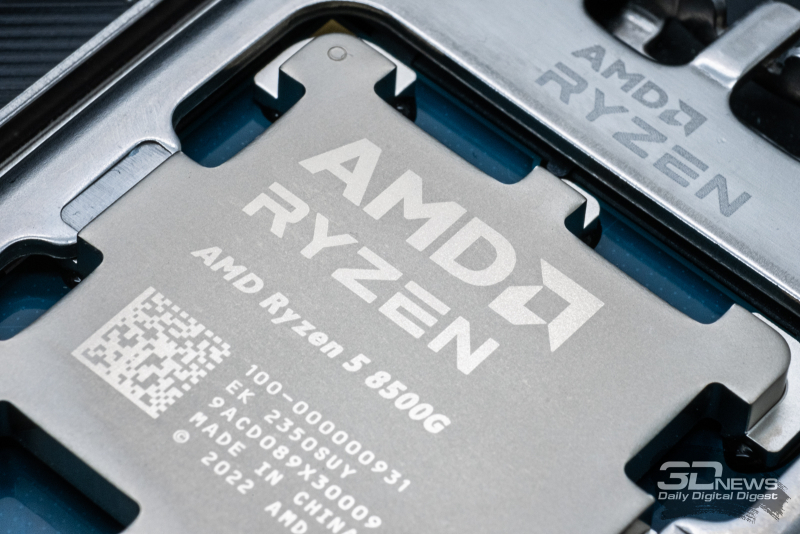
But this does not mean at all that all representatives of the Ryzen 8000G series are not of any interest. In addition to the Ryzen 7 8700G and Ryzen 5 8600G, it includes two more processors. One of them, the quad-core Ryzen 3 8300G, is designed for distribution through OEM channels and is unlikely to be widely sold, and therefore not very interesting. But the six-core Ryzen 5 8500G looks much better: just look at its characteristics.
On the one hand, the Ryzen 5 8500G is cheaper than its neighboring six-core model, the Ryzen 5 8600G, by more than 20%. On the other hand, the specifications of the Ryzen 5 8600G and Ryzen 5 8500G are quite similar, and this suggests that the full-fledged successor to the super-popular Ryzen 5 5600G in the past should not be the overrated Ryzen 5 8600G, but the more affordable Ryzen 5 8500G.
That is why we decided to devote a separate review to the Ryzen 5 8500G. In it we will evaluate this processor as a modern replacement for the Ryzen 5 5600G and answer the questions that arise in connection with this. Can it boast the same revolutionary advances in graphics performance as its other Ryzen 8000G series brethren; and can the Ryzen 5 8500G really be regarded as a more budget modification of the Ryzen 5 8600G?
In addition, the Ryzen 5 8500G is interesting not only because it has a chance to become a universal processor-combine for low-cost gaming systems. It also deserves attention because it is based on the Phoenix 2 semiconductor crystal. This means that the Ryzen 5 8500G is one of the first AMD desktop processors that includes different types of computing cores: productive Zen 4 and efficient Zen 4c.
⇡#What are the Zen 4c cores and what do they do in the Ryzen 5 8500G?
The theme with efficient Zen 4c cores originated in the server segment. The main goal of their creation was to minimize the area occupied by each core on a processor semiconductor chip in order to produce the most multi-core CPUs possible. And ultimately, AMD achieved its goal: it was Zen 4c that became the foundation of the 128-core Epyc Genoa. After that, AMD introduced such cores in the mobile segment, where they made processors not only cheaper, but also more economical. And now Zen 4c cores have reached desktop PCs. Here, just like in mobile processors, they are side by side with regular Zen 4 and solve a similar problem – they reduce the cost of lower APU modifications.
In fact, the Ryzen 5 8500G can be considered an analogue of the mobile Ryzen 5 7545U: it is the same six-core processor with a Phoenix 2 design, which simultaneously uses two types of computing cores: Zen 4 and Zen 4c. But AMD’s hybrid approach, which it embodied in Phoenix 2, has little in common with Intel’s approach. The productive and efficient cores in the Ryzen 5 8500G do not differ in either the basic architecture or the amount of L2 cache, and as a result, have equal performance at the same clock speed. The difference lies in the area that Zen 4 and Zen 4c occupy on the semiconductor chip. Efficient cores are physically smaller, but not due to simplification, but due to the increased density of transistors.
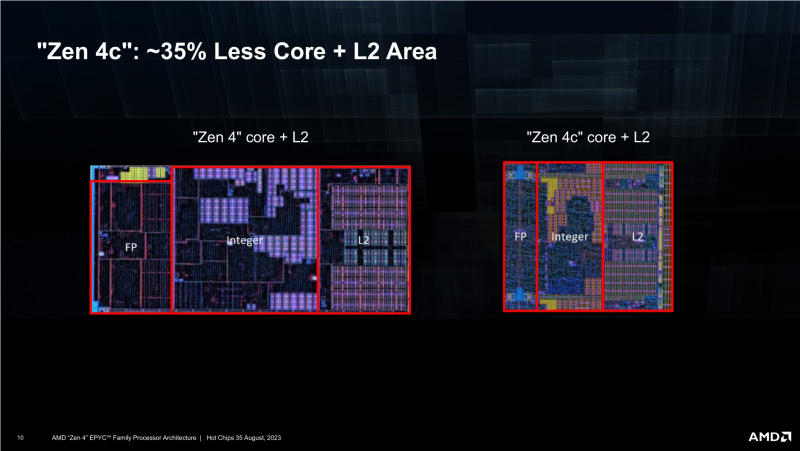
The area of one Zen 4 core is 3.84 mm2. The Zen 4c core is 35% smaller, occupying 2.48 mm2 on the die. At the same time, in the production of both versions of the core, the same technical process with 4-nm standards is used, but when implementing Zen 4c in silicon, other libraries with a higher concentration of transistors per unit surface area of the crystal are used. And this does not go unnoticed: as a result, the denser cores of Zen 4c cannot operate at the same high frequencies as regular Zen 4. Moreover, this difference is quite significant. If the maximum core frequency of Zen 4 exceeds 5 GHz (in some cases even by several hundred megahertz), then the frequency of Zen 4c is limited to 3.7 GHz. This results in the efficiency of Zen 4c: the reduced frequency allows the supply voltage to be reduced, and this entails a reduction in power consumption.
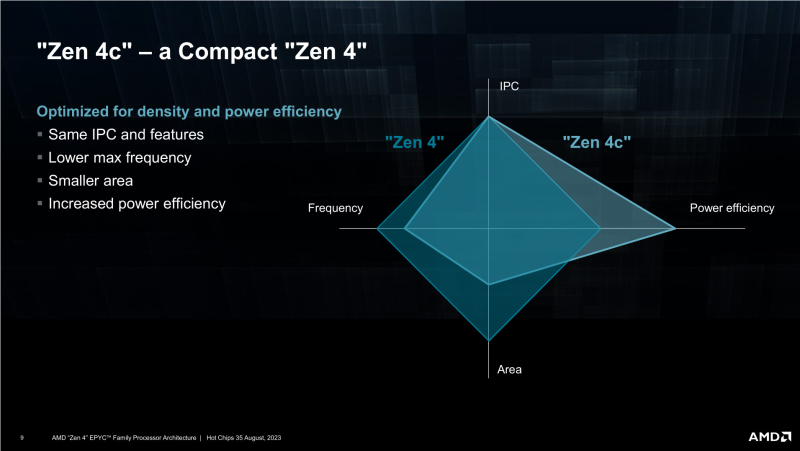
The Phoenix 2 crystal that AMD uses in the Ryzen 5 8500G differs fundamentally from the base Phoenix crystal that underlies the older APUs of the same series (Ryzen 7 8700G and Ryzen 5 8600G). This is initially a six-core silicon, not an eight-core one, in which only two cores are classified as Zen 4, and the remaining four are “densified” Zen 4c. As a result, the total die area of Phoenix 2 is only 137 mm2, while the Phoenix area is 178 mm2.
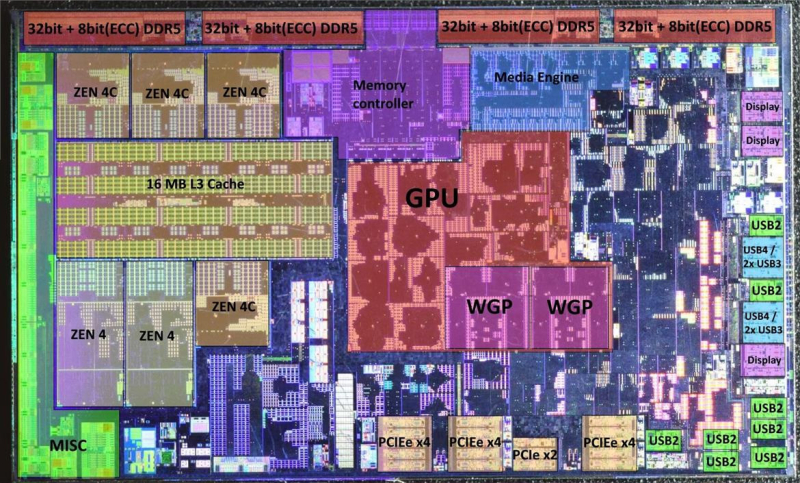
Crystal Phoenix 2
But the savings in silicon in Phoenix 2 are determined not only by the transition from an eight-core to a six-core design and the use of Zen 4c instead of Zen 4. The capabilities of Phoenix 2 are also greatly reduced in terms of integrated graphics: the number of CU units in it has been reduced from 12 to 4 pieces. In addition, this version of the crystal lacks the Ryzen AI AI coprocessor.
⇡#Read more about the characteristics of the Ryzen 5 8500G
The Ryzen 5 8500G is a processor that takes full advantage of the Phoenix 2 chip’s on-chip capabilities. This is a six-core processor in which the maximum frequency of Zen 4 cores reaches 5 GHz, and Zen 4c cores – up to 3.7 GHz; The L3 cache size is 16 MB, and the integrated Radeon 740M graphics uses all available 4 CUs with RDNA 3 architecture and operates at frequencies up to 2.8 GHz.
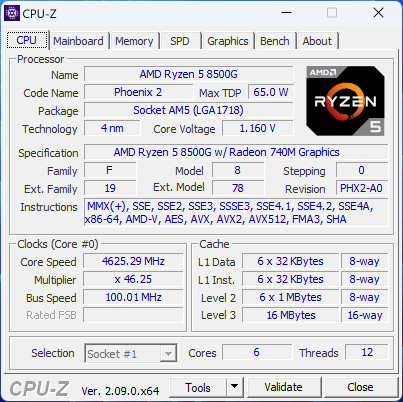
Thus, if we compare two related six-core APUs, which are based on Phoenix and Phoenix 2 crystals – Ryzen 5 8600G and Ryzen 5 8500G – it turns out that the processor with a higher model number wins primarily in terms of the power of the graphics core, which has twice the CU. But there is a second advantage – the ability of all cores of the Ryzen 5 8600G to operate at a multi-threaded load at 4.6 GHz. For the Ryzen 5 8500G, in a similar situation, only two cores belonging to the Zen 4 class will operate at a frequency of 4.6 GHz. The frequency of the rest will be only 3.7 GHz.
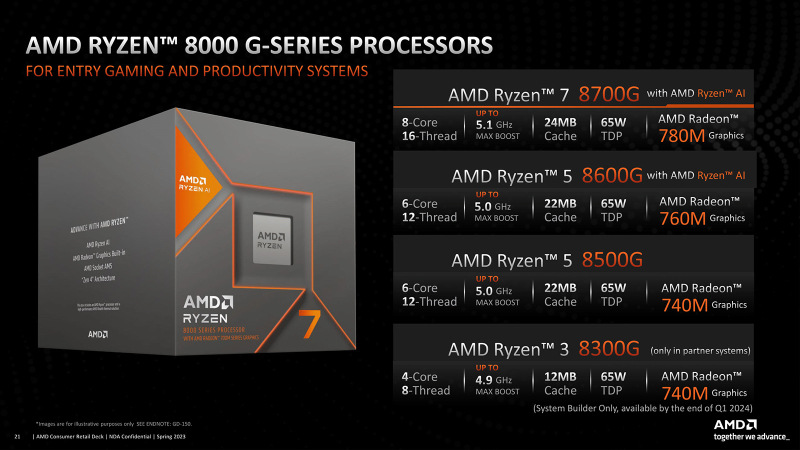
And in general, the frequency formula of the Ryzen 5 8500G, if you look at it, looks very peculiar. The frequency of its Zen 4 part is capable of reaching 5.05 GHz only when loaded on any one, two, three or four cores. If five or six cores are busy, the maximum frequency of Zen 4 cores is strictly limited to 4.6 GHz. At the same time, the Zen 4c cores choose their frequency based on the current frequency of the Zen 4 cores. If they operate at 5.05 GHz, then the Zen 4c cores are set to 3.4 GHz, and if at 4.6 GHz, then 3 .7 GHz.
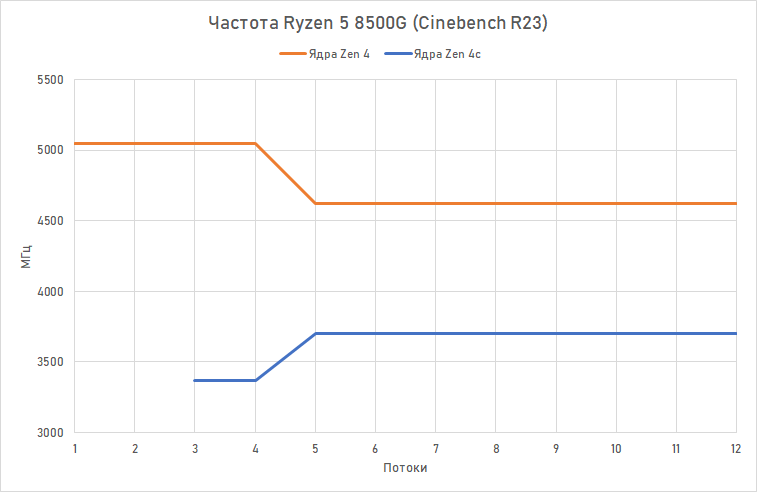
As a result, the Ryzen 5 8500G may have a situation where, as the load intensity increases, the frequency of the Zen 4 cores decreases, and the frequency of the Zen 4c cores increases. For example, such a somersault occurs when moving from a four-threaded to a five-threaded load in the graph below, which we built by observing the frequencies of the Ryzen 5 8500G when rendering in Cinebench R23 with a limit on a different number of active threads. With a four-thread load, two Zen 4 cores run at 5.05 GHz, and two Zen 4c cores run at 3.4 GHz. When another thread comes into play, and the third Zen 4c core is used, the frequency of the Zen 4 cores decreases by 450 MHz, and the Zen 4c cores increase by 300 MHz.
Fortunately, this counterintuitive frequency formula does not cause any problems, since processors with the Phoenix 2 design do not have their own thread distribution mechanisms like Intel Thread Director. Threads are sent to the cores by the standard Windows task scheduler, which is guided by a very simple principle: first the load is sent to the cores with a higher clock frequency, and then to the cores with a lower clock frequency. As for the virtual cores generated by SMT technology, they are loaded last.
Thus, the efficient cores in the Ryzen 5 8500G do not have any orientation towards servicing background tasks, and the Windows scheduler does not take their energy efficiency into account when distributing the load. Even light workloads are always sent to the Zen 4 cores first, and this makes the Ryzen 5 8500G a less power-efficient processor than it could be with proper collaboration between AMD and Microsoft.
However, it is difficult to make any complaints about the efficiency of the Ryzen 5 8500G. According to the official specifications, it, like the Ryzen 5 8600G, is classified as a processor with a 65 W thermal package. Moreover, in practice its maximum consumption during multi-threaded rendering in Cinebench R23 is about 42 W.
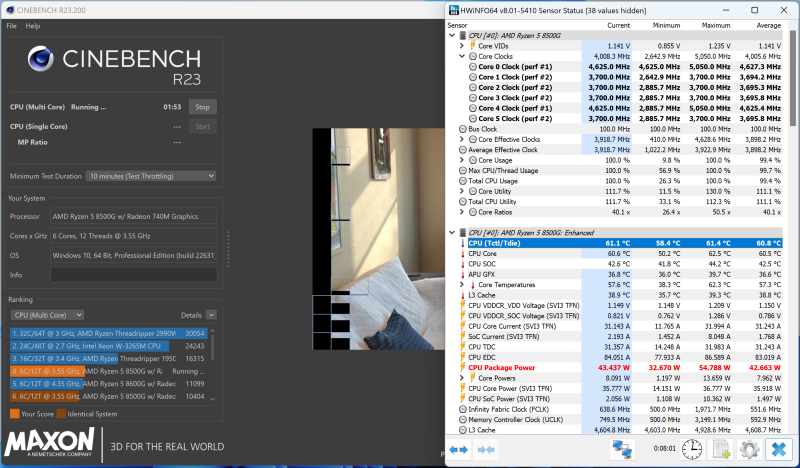
CineBench R23
Let us remind you that a similar Ryzen 5 8600G based on the Phoenix design in the same situation consumes significantly more – about 72 W. However, you need to understand that the energy efficiency of the Ryzen 5 8500G in this comparison is due to the frequency of the Zen 4c cores, which is lower than the frequency of the Zen 4 cores by almost a full gigahertz.
As a result, it turns out that the main consumer of electricity in the Ryzen 5 8500G is not the computing cores at all, but the graphics. For example, with a high graphics load in the Furmark test, APU consumption reaches 55 W.
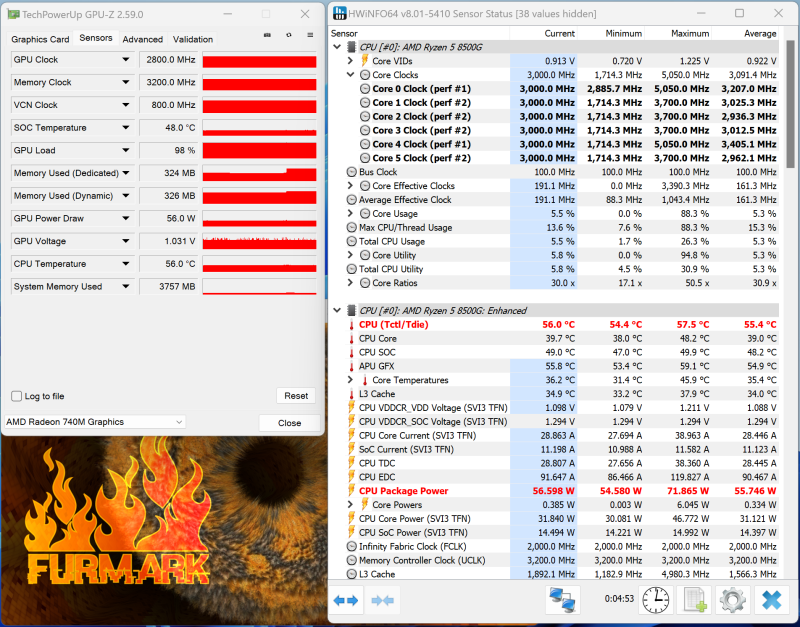
FurMark 2.3
And as a result, with a full and simultaneous load on the graphics and processor cores, the Ryzen 5 8500G still reaches the consumption limit of 88 W set for it. But this has almost no effect on the operating frequencies of the processor. Computing cores continue to operate at maximum frequencies, and the limitation only affects the GPU frequency, which is reduced from a maximum of 2.8 to 2.6-2.7 GHz.
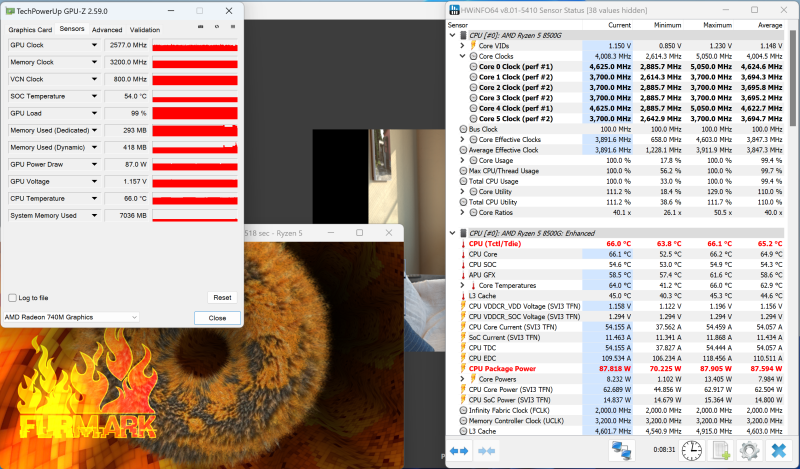
Cinebench R23 + FurMark 2.3
However, the situation in the screenshot above was artificially created by the launch of the most power-hungry applications in their classes – Cinebench R23 and FurMark. In real games, of course, nothing like this is observed. In them, the maximum consumption of the Ryzen 5 8500G (using the integrated graphics core) is about 50-60 W. For example, the following graphs show the measured consumption of the Ryzen 5 8500G in Counter Strike 2 and Cyberpunk 2027.
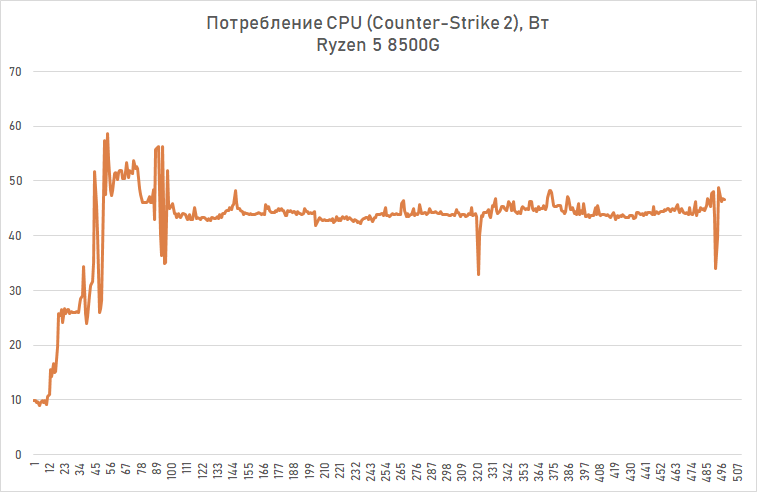
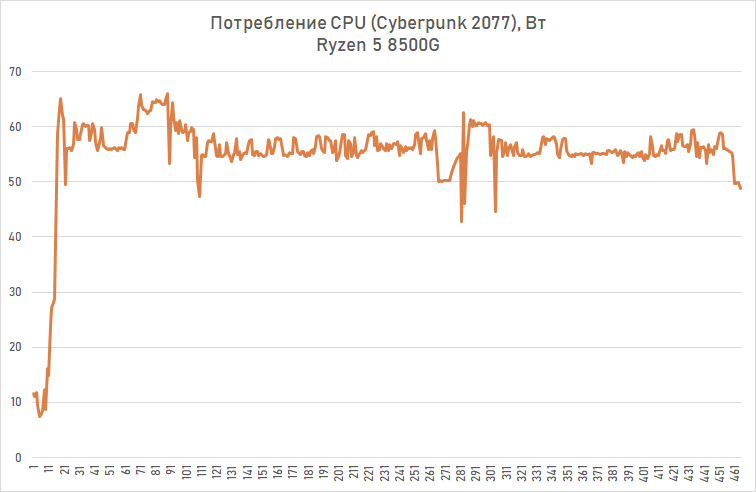
From the results of such measurements, it follows that the Ryzen 5 8500G did not manage to become a more economical APU compared to the Ryzen 5 5600G, at least when it comes to games. The six-core representative of the Cezanne family consumes 5-10 W less under similar conditions. However, there is nothing strange about this. Although the Ryzen 5 8500G is produced using a more modern technical process with 4-nm standards, its Radeon 740M graphics core is significantly more powerful, although at first glance you cannot tell. But let’s dig deeper.
⇡#Radeon 740M graphics: gaming or office?
On the one hand, the Ryzen 5 8500G graphics does not look powerful: it is based on 4 CUs and has 256 shader pipelines, 16 texturing units and 8 rasterization units. For example, the six-core APU of the previous generation, Ryzen 5 5600G, has a much richer arsenal of resources: its GPU consists of 7 CUs and offers 448 shader pipelines, 28 texture units and 8 rasterization units. But on the other hand, all this is offset by the difference in architecture – the Ryzen 5 8500G graphics is based on the RDNA 3 architecture and even has support for hardware ray tracing, while the previous generation APU used the 5th generation GCN graphics architecture (Vega) from seven years ago. In addition, the Ryzen 5 8500G graphics core has a significantly higher frequency – 2.8 versus 1.9 GHz. As a result, in terms of theoretical graphics power, the Ryzen 5 8500G represents a significant step forward. The performance of the Radeon 740M can be estimated at 2.7 teraflops, while the estimated graphics power of the Ryzen 5 5600G is 1.7 teraflops.
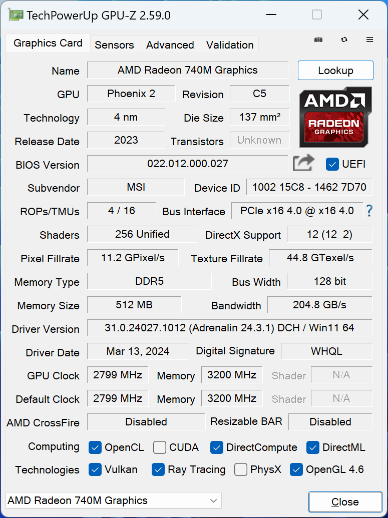
In addition, we must add to this a significant increase in memory bus bandwidth, which has a significant impact on the performance of built-in GPUs. Platforms with Ryzen 5 5600G are equipped with dual-channel DDR4 SDRAM, which provides a throughput of 51.2 GB/s (when operating in DDR4-3200 mode). At the same time, the Ryzen 5 8500G, equipped with at least dual-channel DDR5-5200, can provide the graphics core with access to memory with a bandwidth of 83.2 GB/s.
Thus, the Ryzen 5 8500G, like its older brothers Ryzen 5 8600G and Ryzen 7 8700G, has a good chance of making its way into entry-level gaming systems, even if it is based on a Phoenix 2 die with a cut-down GPU. After all, all this is compensated by the price: the Ryzen 5 8500G now costs around 17-18 thousand rubles, while a similar six-core Ryzen 5 8600G on a Phoenix chip is sold for no less than 24 thousand rubles.
However, you need to be aware that the Radeon 740M is, in a sense, a compromise solution. Compared to the Radeon 780M and Radeon 760M, its specifications are by no means amazing.
But in real-world performance, the gap between the Radeon 780M, Radeon 760M and Radeon 740M is not that dramatic. All three accelerators use the same memory bus, and this smooths out the differences. For example, according to the results of the synthetic benchmark 3DMark Steel Nomad Light, the integrated graphics of the Radeon 780M outperforms the Radeon 740M by 80%, although in terms of specifications the superiority should be threefold.

As for the ratio of the results of the built-in accelerators Radeon 760M and Radeon 740M, the Ryzen 5 8600G graphics, according to 3DMark Steel Nomad Light, is in practice only 32% faster. But for now this is a preliminary estimate; detailed tests in real games are yet to come.
⇡#Ryzen 5 8500G Disadvantages: Overclocking and PCIe
However, even if you don’t pick on graphics performance, it’s still not possible to say that the Ryzen 5 8500G can become a full-fledged successor to the Ryzen 5 5600G. And it’s not just that the six-core APU of the previous generation is now about 40% cheaper in stores. Much worse is that the new generation processor has unpleasant limitations, due to which many will find it inferior to the six-core APU for the Socket AM4 platform.
The first problem with the Ryzen 5 8500G is overclocking. In this processor it is almost completely blocked. It will not be possible to increase the frequency of the built-in cores or overclock the graphics core. In the Ryzen 5 8500G, you can only change the memory frequencies and Infinity Fabric bus. In addition, the Ryzen 5 8500G still has access to the Curve Optimizer function, but in this case it is of little use.
The second, and more serious problem is the PCI Express bus controller. The Phoenix 2 die on which the Ryzen 5 8500G is based was primarily designed with mobile PCs in mind. Therefore, its capabilities for connecting various peripherals are seriously limited, and even more so than in Phoenix chip processors. There is no support for PCI Express 5.0 at all, and the number of PCI Express 4.0 lanes is reduced to 14 (versus 20 in Phoenix and 28 in regular Ryzen 7000). Of these 14 lines, 4 lines go to connect to the chipset, and the remaining 10 are divided between the external video card and NVMe drives.
As a result, when installing a discrete graphics accelerator into a system with Ryzen 5 8500G, it will only be able to use the PCIe 4.0 x4 interface. The first SSD will have the same interface, and the second drive will have to be content with two PCIe 4.0 lanes. And this not only limits the possibility of using Ryzen 5 8500G-based systems with fast SSDs, but also raises questions regarding the advisability of their subsequent upgrade with discrete video cards. However, so far all this does not look so scary: as tests show, video cards available on the market when using PCIe 4.0 x4 instead of PCIe 4.0 x16 lose no more than 10% of performance.
⇡#Description of test systems
So, in terms of graphics capabilities, the Ryzen 5 8500G is quite severely reduced compared to the Ryzen 5 8600G. Nevertheless, it still remains a new generation hybrid processor with modern architectures of computing cores and graphics. Therefore, it would be very appropriate to check how applicable it is in full-fledged entry-level gaming systems.
The main competitors of the Ryzen 5 8500G in such a study will naturally be its older brothers (Ryzen 7 8700G and Ryzen 5 8600G), as well as AMD hybrid processors of the previous generation (Ryzen 7 5700G and Ryzen 5 5600G). In fact, it is this set of processors that covers the full range of options that you can choose to build a gaming system without a discrete graphics card. And here two main questions arise, which we will answer further. How much slower is the six-core Ryzen 5 8500G with Phoenix 2 design than the six-core Ryzen 5 8600G with Phoenix design. And is it really faster than the time-tested six-core Ryzen 5 5600G for the old Socket AM4 platform?
In addition, we will pay attention to how the Ryzen 5 8500G performs in regular applications, as well as in games after installing a discrete video accelerator. The purpose of this part of testing is to find out how good the idea of their subsequent enhancement with the help of an additional video card is.
As a result, the test kits used included a fairly extensive list of components.
-
- AMD Ryzen 7 8700G (Phoenix, 8 cores, 4.2-5.1 GHz, 16 MB L3);
- AMD Ryzen 5 7600X (Raphael, 6 cores, 4.7-5.3 GHz, 32 MB L3);
- AMD Ryzen 5 7500F (Raphael, 6 cores, 3.7-5.0 GHz, 32 MB L3);
- AMD Ryzen 7 5700G (Cezanne, 8 cores, 3.8-4.6 GHz, 16 MB L3);
- AMD Ryzen 5 8600G (Phoenix, 6 cores, 4.3-5.0 GHz, 16 MB L3);
- AMD Ryzen 5 8500G (Phoenix 2, 6 cores, 3.2-5.0 GHz, 16 MB L3);
- AMD Ryzen 5 7600X (Raphael, 6 cores, 4.7-5.3 GHz, 32 MB L3);
- AMD Ryzen 5 7500F (Raphael, 6 cores, 3.7-5.0 GHz, 32 MB L3);
- AMD Ryzen 5 5600G (Cezanne, 6 cores, 3.9-4.4 GHz, 16 MB L3);
- AMD Ryzen 5 5600X (Vermeer, 6 cores, 3.7-4.6 GHz, 32 MB L3);
- Intel Core i5-14400 (Raptor Lake, 6P+4E-core, 2.5-4.7/1.8-3.5 GHz, 20 MB L3);
- Intel Core i5-12400 (Alder Lake, 6P-core, 2.5-4.4, 18 MB L3).
- CPU cooler: custom liquid cooling system made from EKWB components.
-
- ASUS ROG Maximus Z790 Apex (LGA1700, Intel Z790);
- Asus ROG Strix X570-E Gaming WiFi (Socket AM4, AMD X570);
- MSI MPG X670E Carbon WiFi (Socket AM5, AMD X670E).
-
- 2 × 16 Гбайт DDR5-6400 SDRAM (G.Skill Ripjaws S5 F5-6400J3239G16GX2-RS5K);
- 2 × 16 Гбайт DDR4-3600 SDRAM (Crucial Ballistix RGB BL2K16G36C16U4BL).
-
- ASUS Dual GeForce GTX 1650 OC (1515/1755 MHz, 4 GB GDDR5 8 Gbps);
- GIGABYTE GeForce RTX 4090 Gaming OC (AD102 2235/2535 MHz, 24 GB GDDR6X 21 Gbps);
- Disk subsystem: Intel SSD 760p 2 TB (SSDPEKKW020T8X1).
- Power supply: ASUS ROG-THOR-1200P (80 Plus Titanium, 1200 W).
The configuration of memory subsystems in the Socket AM5 and LGA1700 platforms was generally performed using the XMP (EXPO) profile – DDR5-6400 with timings 32-39-39-102. In the Socket AM4 platform, memory was similarly configured using XMP with timings of 16-18-18-38.
The processors were tested with consumption limits corresponding to official specifications. An exception was made for the Core i5-14400 and Core i4-12400, for which the PL1 limit was relaxed to the PL2 level of 154 or 117 W, respectively (most LGA1700 motherboards configure these CPUs in this way). Testing was performed on the Microsoft Windows 11 Pro (23H2) Build 22631.3086 operating system using the following set of drivers:
- AMD Chipset Driver 6.02.07.2300;
- AMD Software Adrenalin Edition 24.3.1.0;
- Intel Chipset Driver 10.1.19600.8418;
- NVIDIA GeForce 552.22 Driver.
⇡#Performance of integrated graphics
Let’s start with the main thing, that is, with an assessment of the performance of the Radeon 740M graphics core built into the Ryzen 5 8500G. The tests below were run at 1080p (with FSR upscaling disabled) in ten games with the following settings:
- Baldur’s Gate 3. Resolution 1920 × 1080, Medium quality settings profile.
- Cyberpunk 2077. Resolution 1920 × 1080, High quality settings profile.
- Counter-Strike 2. Resolution 1920 × 1080, Very High quality settings profile.
- Far Cry 6. Resolution 1920 × 1080, Ultra quality settings profile, no HD textures.
- Fortnite. Resolution 1920 × 1080, High quality settings profile.
- Red Dead Redemption 2. Resolution 1920 × 1080, High quality settings profile.
- Returnal. Resolution 1920 × 1080, Medium quality settings profile.
- Shadow of the Tomb Rider. Resolution 1920 × 1080, Highest quality settings profile.
- The Callisto Protocol. Resolution 1920 × 1080, High quality settings profile.
- The Talos Principle 2. Resolution 1920 × 1080, High quality settings profile.
The FPS results obtained in this test set of games are hardly unexpected. The Radeon 740M graphics turned out to be noticeably slower than the Radeon 760M and Radeon 780M. It lags behind the Radeon 760M, which has twice the number of CUs, by about 30%, and its lag behind the Radeon 780M, which has three times the number of CUs, exceeds 40%. In other words, in terms of the power of the GPU built into the processor, the Ryzen 5 8600G and Ryzen 7 8700G processors, built on the Phoenix design, are fundamentally better than the Ryzen 5 8500G.
However, this is not a reason to give up on the six-core Phoenix 2. Be that as it may, the Ryzen 5 8500G, which has only four CUs, easily surpasses the solutions of the previous generation, and not only the Ryzen 5 5600G, but also the Ryzen 7 5700G, which has 8 CUs, however, are based on the GCN 5 architecture. If we compare processors of the same class – Ryzen 5 8500G and Ryzen 5 5600G – then from the newer APU we can expect an average of 37% higher frame rates in games.

If, when we were introduced to the Ryzen 7 8700G and Ryzen 5 8600G, we said that the integrated graphics of these APUs are capable of replacing entry-level video cards and provide quite acceptable performance in modern games when choosing high or medium picture quality in 1080p resolution, then these words apply to the Ryzen 5 8500G not applicable. Those who decide to choose this particular processor for their gaming build will most likely have to reduce the image quality an additional step. Of course, this is not a disaster, but you need to understand that there is no performance comparable to the GeForce GTX 1650 here. At the same time, the Ryzen 5 8500G provides little room for improving gaming performance. Its GPU, as well as the computing part, does not allow any overclocking. As a result, even in graphically light games like Counter Strike 2 or Fortnite, owners of Ryzen 5 8500G systems will most likely have to sacrifice quality for the sake of sufficient FPS.










However, do not forget that the Ryzen 5 8500G has a good software solution for solving the problem of insufficient frame rate. We are talking about Hyper-RX technology, which is a combine of several means of increasing gaming performance, including Radeon Super Resolution scaling technology built on FSR 1 algorithms, Anti-Lag+ and Radeon Boost tools, as well as AMD Fluid Motion Frames generation technology for additional intermediate frames . This tool is available at the AMD Adrenalin driver level and is applicable to any game – it allows you to reduce the resolution of game rendering (with the final image output at 1080p) without significantly compromising image quality.
⇡#Application Performance
CPU performance tests of the Ryzen 5 8500G were carried out with the GeForce RTX 4090 discrete video accelerator installed in the system. The following benchmarks and applications were used:
- 7-zip 23.01 — compression and decompression speed testing. Built-in benchmark with dictionary size up to 64 MB is used.
- Adobe Photoshop 2023 24.7.1 — testing performance when processing graphic images. The PugetBench for Photoshop V0.93.7 test script is used, simulating basic operations and working with the Camera Raw Filter, Lens Correction, Reduce Noise, Smart Sharpen, Field Blur, Tilt-Shift Blur, Iris Blur, Adaptive Wide Angle, Liquify filters.
- Adobe Photoshop Lightroom Classic 12.5 — testing performance in batch processing of a series of RAW images. The PugetBench for Lightroom Classic V0.95 test script is used, simulating basic work with the library and editing, as well as import/export, Smart Preview, creation of panoramas and HDR images.
- Adobe Premiere Pro 2023 23.6.0 — testing video editing performance. The PugetBench for Premiere Pro V0.98 test script is used, simulating editing 4K videos in different formats, applying various effects to them, and the final rendering for YouTube.
- Blender 4.0 — testing the speed of final rendering on CPU. The standard Blender Benchmark is used.
- Corona 10 — testing the speed of final rendering on CPU. The standard Corona Benchmark is used.
- Microsoft Visual Studio 2022 (17.8.0) – Measuring the compilation time of a large MSVC project – Blender version 4.0.
- Stockfish 16.0 — testing the speed of a popular chess engine. A standard benchmark with an analysis depth of 30 half-moves is used.
- SVT-AV1 1.7 — testing the speed of video transcoding to AV1 format. The original 4K@24FPS video with 10-bit color and a bitrate of 51 Mbps is used.
- Topaz Video AI v4.0.3 — testing the performance of video quality enhancement using CPU-based AI algorithms. The original 640×360@30FPS video is scaled using the Artemis model to 1280×720 resolution, and the FPS is raised to 60 using the Apollo model.
- X264 164 r3107 — testing the speed of video transcoding to H.264/AVC format. The original 4K@24FPS video with 10-bit color and 51 Mbps bitrate is used.
- X265 r12776 — testing the speed of video transcoding to H.265/HEVC format. The original 4K@24FPS video with 10-bit color and 51 Mbps bitrate is used.
- V-Ray 5.00 – testing the speed of final rendering on the CPU. The standard V-Ray 5 Benchmark is used.
The processor part of the Ryzen 5 8500G is similar to that of the Ryzen 5 8600G – it is a similar six-core processor based on Zen 4 architecture with L3 cache reduced to 16 MB. But despite this, the advantage of the Ryzen 5 8600G in resource-intensive applications cannot be called insignificant, since these two CPUs have significantly different frequency formulas. The Ryzen 5 8500G has only two fast cores that operate at the usual Zen 4 frequencies of 4.6-5 GHz, while the remaining cores belong to the Zen 4c class and, at best, operate at 3.7 GHz. As a result, the average frequency of the Ryzen 5 8500G under multi-threaded loads can be characterized as about 4 GHz, while the frequency of the Ryzen 5 8600G under the same conditions is 4.6 GHz. Therefore, the observed performance advantage of the Ryzen 5 8600G at 12% should not surprise anyone.
But in low-threaded workloads this gap is much smaller, because the Ryzen 5 8500G has two high-speed cores that operate at the same frequencies as the Ryzen 5 8600G cores. And this is good news for those users who do not intend to use Ryzen 5 8500G systems to create or process digital content. For general office and home needs, the Ryzen 5 8500G and Ryzen 5 8600G are about the same.
However, any of the APUs is inferior in performance to the “full-fledged” Ryzen 7000, which have higher frequencies and have twice the capacity of the L3 cache. Even the inexpensive six-core Ryzen 5 7500F is capable of providing a 20% performance advantage, not to mention the Ryzen 5 7600X, which outperforms the Ryzen 5 8500G by 25-30% in resource-intensive tasks.
As a result, in terms of computing performance, the Ryzen 5 8500G can only be compared with the Ryzen 5 5600X or Core i5-12400 – six-core processors that appeared on the market three or four years ago. And this can be called a payment for hybridity, because of which there is not much space left for the implementation of the classic processor part in the Phoenix 2 chip.
Rendering:
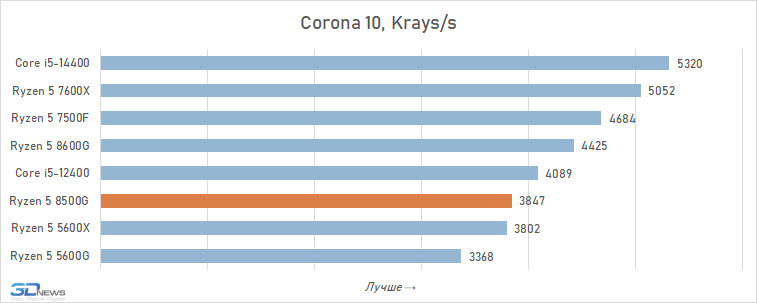
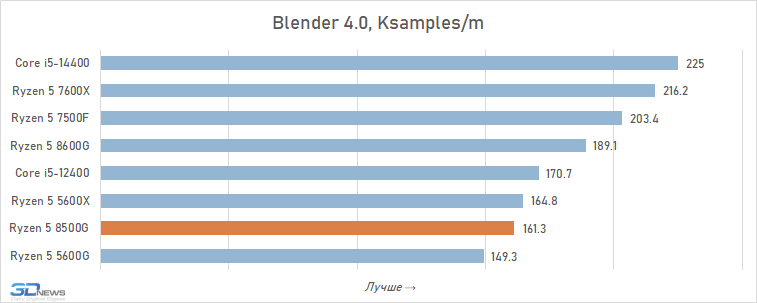
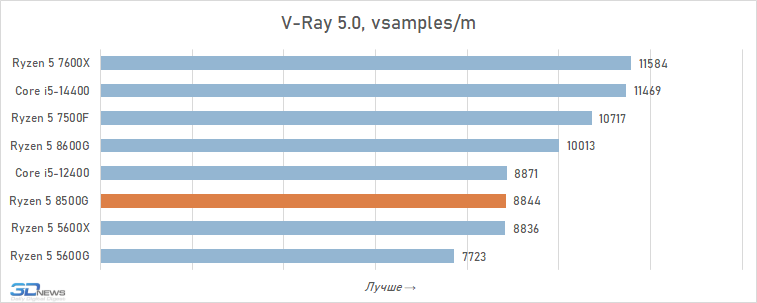
Video transcoding:
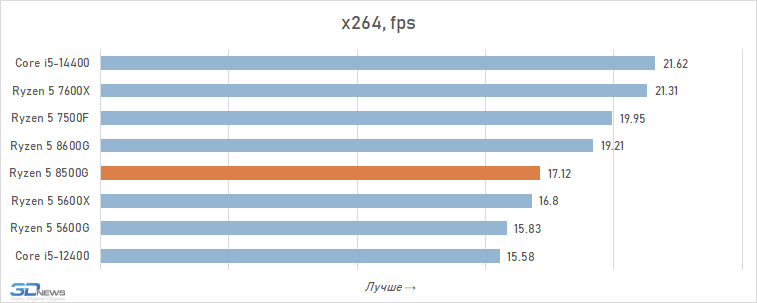
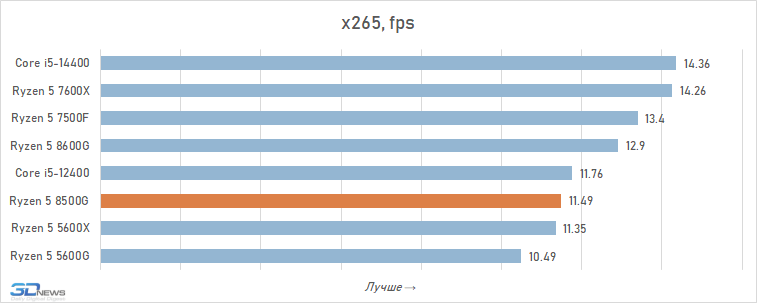
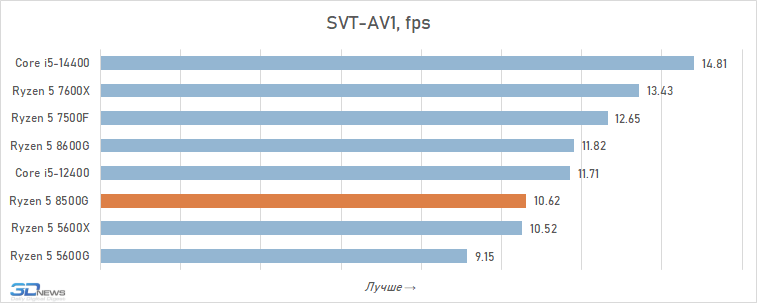
Photo processing:
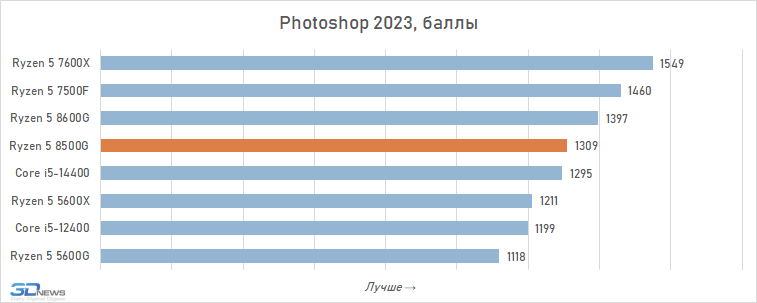
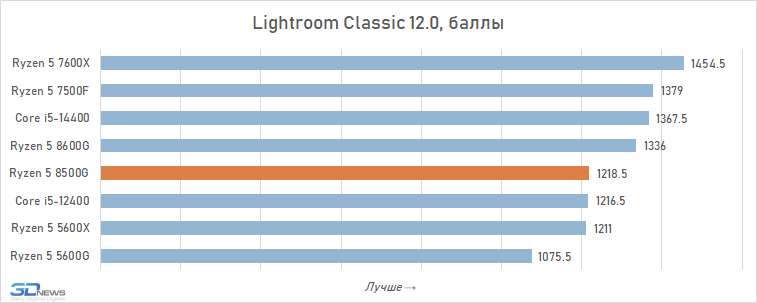
Work with video:
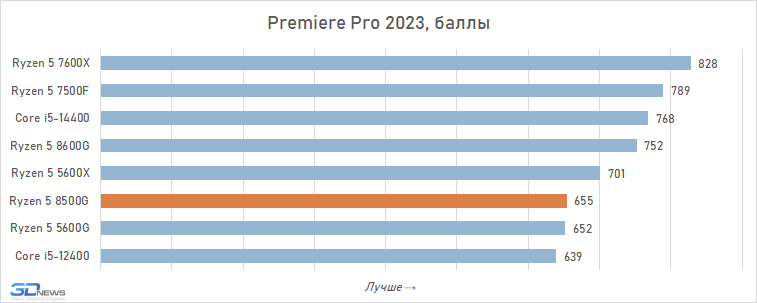
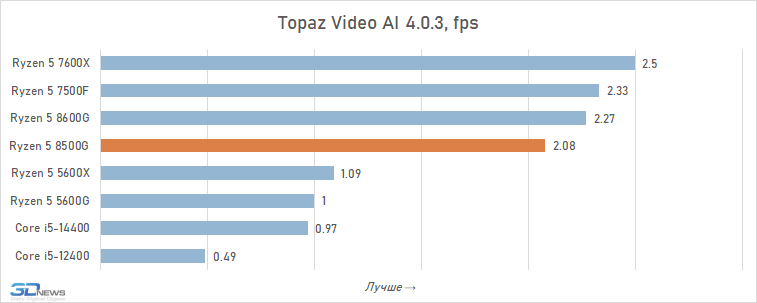
Compilation:
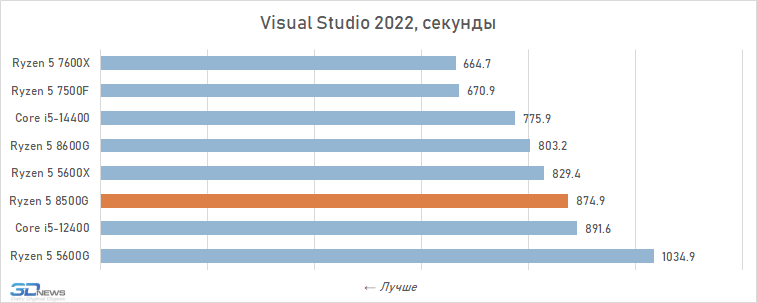
Archiving:
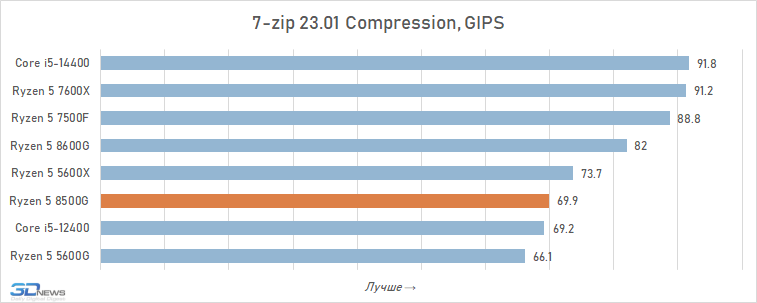
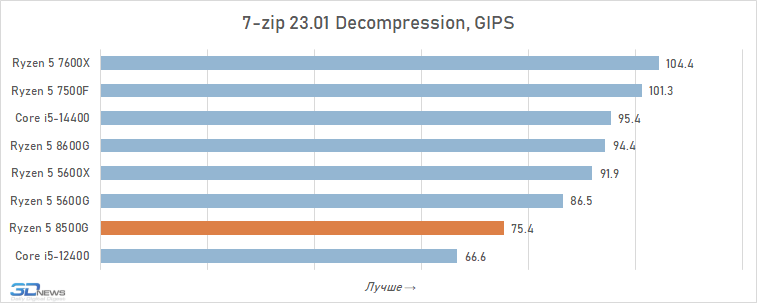
Chess:
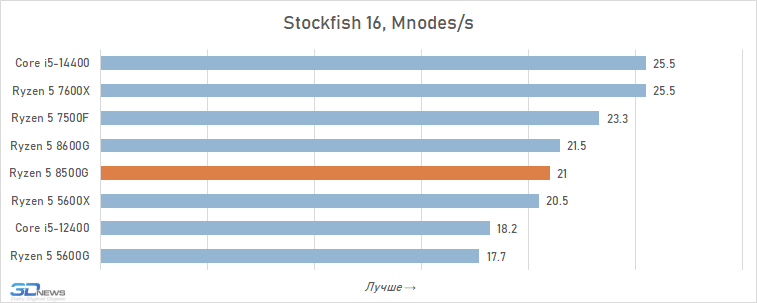
⇡#Gaming performance with discrete graphics
AMD hybrid processors are often purchased with a view to subsequently upgrading the system by installing a discrete video card. That is why it makes sense to pay special attention to the question of how it works with the Ryzen 5 8500G with powerful external graphics. Moreover, this processor gives serious cause for concern. It only allocates four PCIe 4.0 lanes to the first PCIe x16 slot on the motherboard, which could potentially not be enough to provide sufficient performance.
For practical testing, we used the GeForce RTX 4090 video card and the following set of games:
- Baldur’s Gate 3. Graphics settings: Vulcan, Overall Preset = Ultra.
- Cities: Skylines II. Настройки графики: Global Graphics Quality = High, Anti-aliasing Quality = Low SMAA, Volumetrics Quality Settings = Disabled, Depth of Field Quality = Disabled, Level of Detail = Low.
- Cyberpunk 2077 2.01. Graphics settings: Quick Preset = RayTracing: Medium.
- Dying Light 2. Graphics settings: Quality = High Quality Raytracing.
- Hitman 3. Настройки графики: Super Sampling = 1.0, Level of Detail = Ultra, Texture Quality = High, Texture Filter = Anisotropic 16x, SSAO = Ultra, Shadow Quality = Ultra, Mirrors Reflection Quality = High, SSR Quality = High, Variable Rate Shading = Quality.
- Hogwarts Legacy. Настройки графики: Global Quality Preset = Ultra, Ray Tracing Quality = Low, Anti-Aliasing Mode = TAA High.
- Marvel’s Spider-Man Remastered. Настройки графики: Preset = Very High, Ray-Traced reflection = On, Reflection Resolution = Very High, Geometry Detail = Very High, Object Range = 10, Anti-Aliasing = TAA.
- Mount & Blade II: Bannerlord. Graphics settings: Overall Preset = Very High.
- Shadow of the Tomb Raider. Настройки графики: DirectX12, Preset = Highest, Anti-Aliasing = TAA, Ray Traced Shadow Quality = Ultra.
- Starfield. Graphics settings: Graphics Preset = Ultra, Upscaling = Off.
- The Riftbreaker. Настройки графики: DirectX12, Texture Quality = High, Raytraced soft shadows = On, Ray traced shadow quality = Ultra, Raytraced ambient occlusion = On.
- The Witcher 3: Wild Hunt 4.04. Graphics settings: Graphics Preset = RT Ultra.
Judging by the 1080p results, there’s not much to worry about. The gaming performance of the Ryzen 5 8500G and Ryzen 5 8600G when paired with the flagship GeForce RTX 4090 graphics card does not differ too noticeably. The average frame rate lag of the Ryzen 5 8500G is 7%.
But at the same time, you need to understand that six-core APUs and six-core CPUs made by AMD are far from the same thing. Processors like the Ryzen 5 8500G with reduced cache memory are much weaker than their relatives in the Ryzen 7000 series, despite the fact that both use the Zen 4 architecture. For example, in tests with discrete graphics, the Ryzen 5 7500F turns out to be more productive than the Ryzen 5 8500G, by a fairly significant 22%. It turns out to be faster than the Ryzen 5 8500G and the six-core Core i5-12400. In this case, the advantage is smaller, but it is also expressed in a double-digit percentage.
In other words, if you are counting on a subsequent upgrade, it is better to immediately rely on combinations of conventional processors and inexpensive video cards, and not on hybrid options. The most convincing illustration of this thesis should be the fact that after equipping the Ryzen 5 8500G with discrete graphics, it cannot reach the performance level of even the Ryzen 5 5600X, that is, in fact, it lags behind the full-fledged solutions of AMD itself by more than one generation.
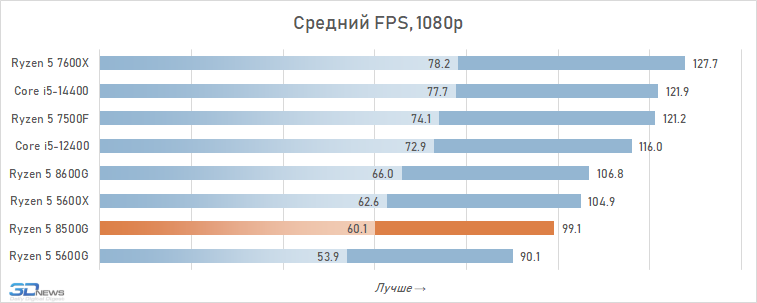
The results for individual games only confirm what has been said. The Ryzen 5 8500G loses to the Ryzen 5 5600X in 10 of the 12 games in our test suite. And the Core i5-12400 turns out to be faster than the protagonist of this review in all 12 games, and in some cases its superiority exceeds 25%.
When moving to 2160p resolution, the situation does not fundamentally change. Typically, increasing the resolution allows you to mask the weakness of a particular processor, since the lion’s share of the load is transferred to the video card. But not in the case of the Ryzen 5 8500G. This is where the stripped-down graphical interface comes into play, which is why this processor continues to show clearly worse results compared to both the Ryzen 5 5600X and the Core i5-12400. But its lag behind the Ryzen 5 8600G looks especially significant. At 1080p resolution the difference in FPS was about 7%, and when moving to 2160p it does not become smaller, which completely contradicts the usual trend.
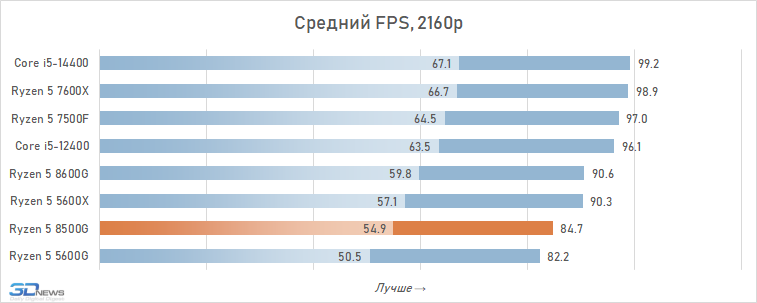
Moreover, there are games where the gap between the results of the Ryzen 5 8600G and the Ryzen 5 8500G reaches 10 or even 15%. This means that the stripped-down PCI Express interface in the junior six-core APU still cannot be called an insignificant factor. This is another good reason why choosing this processor with an eye toward further upgrading the video subsystem is far from the best strategy.
⇡#Conclusions
The Ryzen 5 8500G is notable primarily for its price. Of all the processors for Socket AM5, this is the most affordable option (at least in theory). Moreover, for $179, at which AMD officially priced it, it offers not only six cores with Zen 4 architecture, but also a graphics core capable of delivering fairly passable performance in modern games. Summarizing all these facts, it is not difficult to come to the conclusion that the Ryzen 5 8500G is in general similar to the modernized version of the Ryzen 5 5600G with support for DDR5 memory and improved computing and graphics performance.
However, after we got to know the Ryzen 5 8600G, the capabilities of the Ryzen 5 8500G are no longer impressive at all. Hybrid processors with the Phoenix design really pleasantly surprised with their integrated graphics core, which competes on equal terms with entry-level discrete video cards and is capable of delivering acceptable FPS in modern games in Full HD resolution with medium or high quality settings. Unfortunately, the Ryzen 5 8500G did not inherit this feature from its older brothers. Its built-in GPU is seriously truncated in power, and its performance is exactly between the Ryzen 5 8600G and Ryzen 5 5600G, which somewhat narrows the omnivorousness of entry-level gaming systems where such a processor will be used.
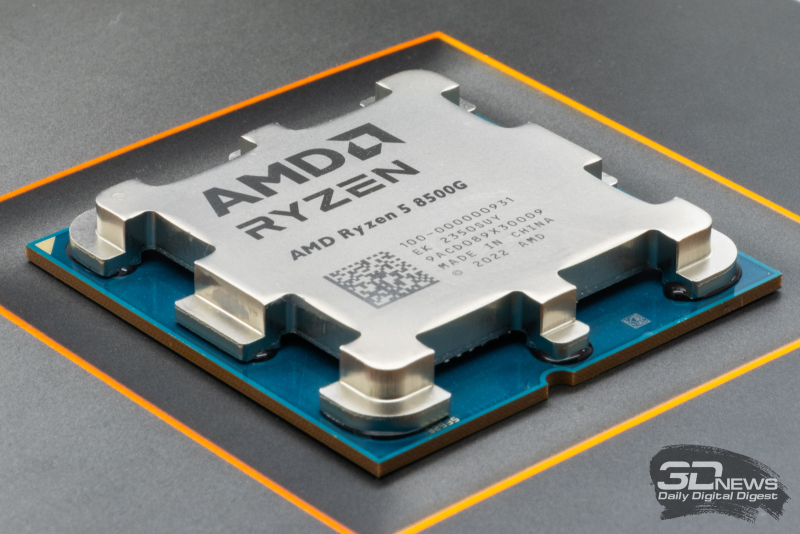
Whether the 30% lag between the Ryzen 5 8500G graphics and the Ryzen 5 8600G graphics is compensated for by a lower price is debatable. But at least you can think about buying the Ryzen 5 8500G on a limited budget. Potentially, it can become the starting point for assembling a full-fledged and modern gaming configuration, which, if possible, will first be supplemented with a discrete video card, and then improved by replacing the Ryzen 5 8500G with some other AMD CPU. Moreover, the last point in such a scenario clearly should not be neglected, because today’s hero not only limits gaming performance with a reduced L3 cache, but also communicates with an external video card via a too narrow PCIe 4.0 x4 bus. And if we keep this plan in mind, then the Ryzen 5 8500G has a much higher chance of repeating the success of the Ryzen 5 5600G than the $230 Ryzen 5 8600G, especially since AMD has already begun to reduce prices for the latest generation of APUs, and the Ryzen 5 8500G It became possible to buy not for the officially announced $179, but for $160.
In addition to the applicability of the Ryzen 5 8500G in low-cost gaming PCs, a separate set of questions was associated with its atypical design, since this is the first AMD desktop processor in which cores of different types coexist – productive Zen 4 and efficient Zen 4c. However, in reality, the Ryzen 5 8500G turned out to be completely different from current Intel processors. Its cores differ only in clock speed, but not in architecture; plus AMD has not provided any mechanisms for distributing the load depending on its nature, as a result of which all threads by default are sent first to higher-frequency cores. This makes the Ryzen 5 8500G less power efficient than it could be, but it’s not a problem. This processor is significantly more economical than the Ryzen 5 8600G, and its consumption in games is about 50-60 W. This means, among other things, the Ryzen 5 8500G can be a good option for mini- and even nano-PCs, especially since its characteristics are similar to the Ryzen Z1, which is used to make game consoles like Asus ROG Ally and Lenovo Legion Go.